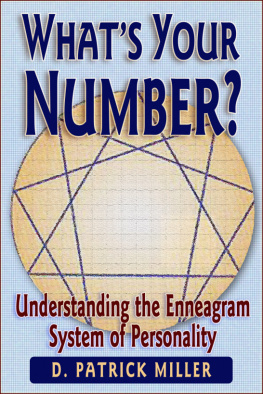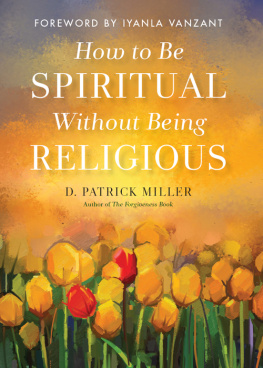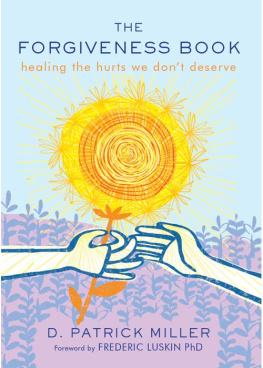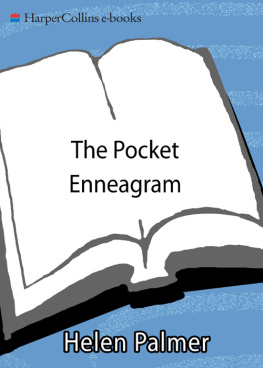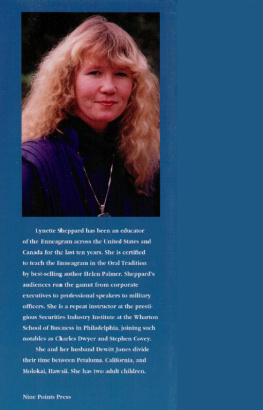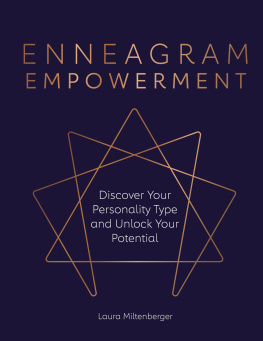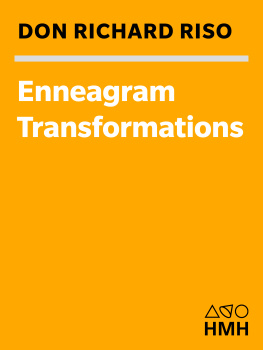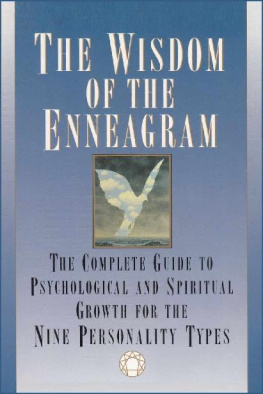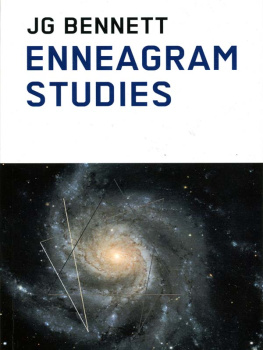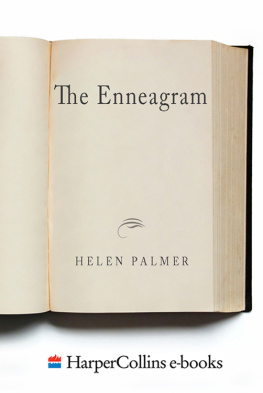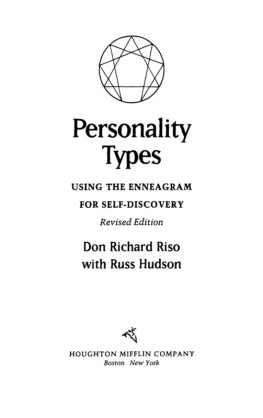D. Patrick Miller - Whats Your Number? Understanding the Enneagram System of Personality
Here you can read online D. Patrick Miller - Whats Your Number? Understanding the Enneagram System of Personality full text of the book (entire story) in english for free. Download pdf and epub, get meaning, cover and reviews about this ebook. year: 2009, publisher: D. Patrick Miller, genre: Romance novel. Description of the work, (preface) as well as reviews are available. Best literature library LitArk.com created for fans of good reading and offers a wide selection of genres:
Romance novel
Science fiction
Adventure
Detective
Science
History
Home and family
Prose
Art
Politics
Computer
Non-fiction
Religion
Business
Children
Humor
Choose a favorite category and find really read worthwhile books. Enjoy immersion in the world of imagination, feel the emotions of the characters or learn something new for yourself, make an fascinating discovery.
- Book:Whats Your Number? Understanding the Enneagram System of Personality
- Author:
- Publisher:D. Patrick Miller
- Genre:
- Year:2009
- Rating:3 / 5
- Favourites:Add to favourites
- Your mark:
- 60
- 1
- 2
- 3
- 4
- 5
Whats Your Number? Understanding the Enneagram System of Personality: summary, description and annotation
We offer to read an annotation, description, summary or preface (depends on what the author of the book "Whats Your Number? Understanding the Enneagram System of Personality" wrote himself). If you haven't found the necessary information about the book — write in the comments, we will try to find it.
Whats Your Number? Understanding the Enneagram System of Personality — read online for free the complete book (whole text) full work
Below is the text of the book, divided by pages. System saving the place of the last page read, allows you to conveniently read the book "Whats Your Number? Understanding the Enneagram System of Personality" online for free, without having to search again every time where you left off. Put a bookmark, and you can go to the page where you finished reading at any time.
Font size:
Interval:
Bookmark:
Whats YourNumber?
Understanding theEnneagram
System of Personality
by D. Patrick Miller
2014 by D. Patrick Miller
All Rights Reserved
SMASHWORDS EDITION
_______________________________
PERFECTIONIST / REFORMER
GIVER / HELPER
PERFORMER / STATUS SEEKER
TRAGIC ROMANTIC / INDIVIDUALIST
OBSERVER / INVESTIGATOR
LOYAL SKEPTIC / LOYALIST
EPICURE / ENTHUSIAST
BOSS / CHALLENGER
MEDIATOR / PEACEMAKER
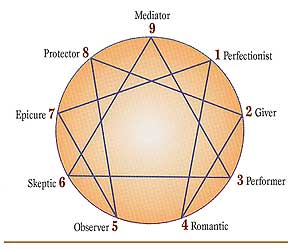
In this age of the spiritualsupermarket, certain signs indicate the irreversible entry ofesoteric knowledge into popular awareness. Take this personal adfrom a weekly newspaper in California:
Enneagram 9, gentle, fiery, svelte, andrare, seeks 35 to 37, good-looking Cancer man with Leo moon,evolved Enneagram 9 or 8. Richness, depth, passion and partnershippossibilities.
This ad suggests that knowing the answer toWhats your sign? may soon no longer suffice as standard singlesbar reparte. Hipsters on the make had better be ready with a replyto Whats your Enneagram number? and the cognoscenti should beable to furnish their dominant wing as well.
To the uninitiated, this may all sound like somuch gobbledygook. Those familiar with the history of the Enneagrammay shake their heads in dismay at the apparent corruption of yetanother profound spiritual legacy. But for better or worse, theEnneagram is doubtless here to stay, and spread, in popularconsciousness.
What is the Enneagram?
Strictly speaking, theEnneagram is a nine-pointed star, a symbol of ancient and uncertainorigins that may have once served as a mathematical map of cosmicreality. According to J.G. Bennett in Enneagram Studies , the symbol couldbe used to represent every process that maintains itself byself-renewal, including, of course, life itself. Most scholarstrace it back at least 2500 years to the secret Sufi society knownas the Sarmouni Brotherhood.
The Enneagram was introduced to the West bythe mystic G.I. Gurdjieff, who had it painted on the floor at hisInstitute for the Harmonious Development of Man. There it was usedas the pattern for an elaborate choreography of movement exercises,designed to imbue Gurdjieffs students with an instinctive sense ofhow fundamental cosmic processes are played out in the materialworld.
Gurdjieff did not directly teach theEnneagram of personality that is rapidly gaining adherents today.That system is universally credited to Oscar Ichazo, founder of theArica Institute, who claims that he learned the Enneagram directlyfrom Sufi teachers in Afghanistan before he became familiar withthe writings of Gurdjieff.
At any rate, Ichazo was the teacher ofClaudio Naranjo, who further developed the psychological profilesof nine basic personality types corresponding to the points of theEnneagram. Naranjo in turn began teaching the system in the early70s. Some of his earliest students were American Jesuit priests,who sparked a rapid dissemination of the knowledge in the Jesuitcommunity.
Until the early 1970s, theEnneagram was transmitted as an oral teaching, in keeping with theSufi tradition. By 1973, brief notes on the personality types couldbe found at Jesuit theological centers in Berkeley and Chicago. Butthere was no book presenting a modern understanding of theEnneagram until 1984, when Roman Catholic authors Maria Beesing,Robert J. Nogosek, and Patrick OLeary published The Enneagram: A Journey ofSelf-Discovery . Popular among Catholicreaders, this book did not gain a general readership and is faultedby some for a narrowly religious view of the Enneagram.
Teachers and Controversies
Although new Enneagram teachers and authorsseem to pop up almost daily, the two best-known proponents of thesystem for the American general audience are Helen Palmer ofBerkeley, California, and the late Don Riso (writing and teachingwith partner Russ Hudson) of New York City. Riso was a formerJesuit seminarian who encountered the Enneagram in 1974 in Toronto,when fellow students familiar with the system assigned him a Sufinumber. Annoyed at being pigeonholed by a typology he firstregarded as just another California fad, Riso resisted theEnneagram until his repeated exposures to it in the Jesuitenvironment encouraged him to see beyond the glib use of thesystem to the genuine insights it contains.
Risos first book on theEnneagram, PersonalityTypes : Using the Enneagram forSelf-Discovery , appeared in 1987 and hasbeen followed by several more, including The Wisdom of the Enneagram . Until his passing in 2012, he developed newmaterial based chiefly on observation and intuition and givesworkshop trainings with his partner Russ Hudson through theEnneagram Institute.
Palmer is a psychologyteacher and intuitive counselor who co-directs an Enneagramteaching center and gives trainings worldwide. (In 1979, she wasthe subject of an aggressive investigation by Mother Jones magazine, whichattempted, and failed, to debunk her psychic abilities.) A studentof Naranjo, Palmer has taught thousands of people the Enneagramusing live panel discussions with identified exemplars of the ninetypes. Her first book TheEnneagram : Understanding Yourself and theOthers in Your Life was released in 1988,followed by The Enneagram in Love andWork .
Whether it originated with the crazy-wiseSufis or the problematic Gurdjieff, the legacy of the Enneagrammaterial seems charged with controversy. Oscar Ichazo repeatedlytried, by legal means, to stop dissemination of the teaching beyondArica circles, claiming that other teachers publishedinterpretations of the Enneagram constituted copyrightinfringement. The courts consistently disagreed, construing theEnneagram of personality as an idea, which by definition belongs tothe public domain and is therefore fair game for any and allinterpreters.
Those interpreters as well are prone todisagree about who has really got it right. Palmer and Riso, forexample, held vigorous differences on the system. Still, its safeto say that the central aspects of their respective teachingscorrespond for the most part.
As a student of the Enneagram myself since1986, Im less interested in investigating controversies than incollecting valuable insights on the practical use that people canmake of the system. This is the first report to provide originalcomments of Riso and Palmer side-by-side. It has been continuallyupdated since its original publication, most recently in 2014.
Why Study the Enneagram?
Those unfamiliar with the Enneagram mightwonder why anyone would find it worth fighting over. The shortanswer: As a guide to human character, behavior, and motivation, itsimply has no equal. Simpler to grasp initially than astrology andmore applicable than typologies derived from psychological testing,the Enneagram provides a clear and easily recognizable map of ninedistinct personality patterns. For most people, it simply ringstrue.
In his preface to Palmers first book,renowned consciousness researcher Charles T. Tart describes hisexperience with the Enneagram in terms that will be familiar to itsdedicated students. When the nature of my type was explained tome, Tart writes, it was one of the most insightful moments of mylife. All sorts of puzzling events and reactions in my life nowmade excellent retrospective sense to me. Even more important, Icould see the central way in which my approach to life wasdefective and I had a general outline of the ways to work onchanging it. I understood the behavior of many of my friends once Icould type them and was able to interact more effectively with themand be a better friend. Years of personal growth work followingthat initial set of insights identifying my Enneagram typecontinued to validate the usefulness of the system to me.
Next pageFont size:
Interval:
Bookmark:
Similar books «Whats Your Number? Understanding the Enneagram System of Personality»
Look at similar books to Whats Your Number? Understanding the Enneagram System of Personality. We have selected literature similar in name and meaning in the hope of providing readers with more options to find new, interesting, not yet read works.
Discussion, reviews of the book Whats Your Number? Understanding the Enneagram System of Personality and just readers' own opinions. Leave your comments, write what you think about the work, its meaning or the main characters. Specify what exactly you liked and what you didn't like, and why you think so.

